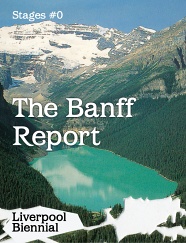
Using Strategies as Tactics: Liverpool Waters and Irrationality in Banff
Ryan Ferko
Michel DeCerteau’s articulation of everyday life revolves around what he calls ‘strategies’, as opposed to tactics. Strategies are outlined in his volume The Practice of Everyday Life as the calculation and establishment of power relationships over space by an individual, group or organisation.1 Strategies ‘pin their hopes on the resistance that the establishment of a place offers to the erosion of time’.2 In Liverpool, this erosion of time is being enabled by the establishment of an irrational place – Liverpool Waters – which proposes a massive, long-term development programme that seeks to build private office and condo towers in a city that has seen consecutive decades of depopulation – a situation that can be articulated as an urban crisis. Strategically, this project is being justified in relation to history, drawing on the nostalgia of the city’s past while disregarding its relationship to the city’s present and future.
This use of nostalgia is anticipated by DeCerteau, who explains, ‘Narrated history creates a fictional space. It moves away from the “real” – or rather, it pretends to escape present circumstances.’3 Official marketing for the development clearly narrates this escape from the present circumstances of the city: ‘The Liverpool Waters proposals are bold and ambitious. They reflect the essential characteristics of Liverpool which are associated with the Outstanding Universal Value of its World Heritage Site such as the city’s historic vision and determination, its commercial astuteness, and its spirit of internationalism.'4
For DeCerteau, tactics, inversely, oppose and subvert strategies of power as ‘an art of the weak’.5 While strategies homogenise space and establish power, tactics momentarily appear as ephemeral, everyday and often playful forms of opposition: ‘Because it does not have a place, a tactic depends on time – it is always on the watch for opportunities that must be seized “on the wing”. Whatever it wins, it does not keep.'6 In an attempt to consider the strategies utilised by Liverpool Waters, two projects were initiated as part of the Banff Centre’s Research in Culture Residency (BRiC) 2013. These projects, critical (and satirical) in their origin, operate as tactics, though they appropriate the strategies of Liverpool Waters in an attempt to isolate and subvert the development’s escape from the present through its narration of history.
The Banff Coal Endowment Society
The Banff Coal Endowment Society (BCES) was founded on 14 June 2013 in order for the Bankhead Coal Mine, which closed in 1922, to emulate the nostalgia of Liverpool Waters. The BCES has independently (and temporarily) revived the mine, sifting through its coal remainders in order to offer a contribution to an irrational development in the form of combustibles. Just as coal historically powered the ‘essential characteristics’ with which Liverpool Waters associates itself, the BCES aims to revive the essential characteristics of the Bankhead Mine and its history, while linking the two organisations through strategies of nostalgia. The coal shipment was displayed at the Banff Centre, along with a press release and information package, before being sent to the Fiddlers Ferry Power Station on 22 June 2013. The progress of this shipment can be tracked at http://banffcoal.info.
Proposal for a Walk
On 12 June 2013, a walk was proposed to the residents of the Banff Centre. A reversal of the freedom sought by the Situationists’ derive,the walk imposed Liverpool’s world-heritage site on an open area just outside of the Town of Banff. Generated from The Guardian’s directions for a tourist walk, the proposal put faith in the narrated history of Liverpoolwhile engaging Liverpool Waters’ abstract space of Outstanding Universal Values.7 However, the universality of the space proved misleading, with the route failing when it brought its participants to a fenced section of the Trans-Canada Highway, which in turn backed onto a secured area surrounding the Banff Regional Airport. Future visitors to Banff are encouraged to attempt the walk.8 Conversely, visitors to the 2014 Liverpool Biennial are encouraged to attempt the failed version of the Banff walk.
1 Michel de Certeau, The Practice of Everyday Life University of California, Press, Berkley, 1984, p.29–42.
2 Ibid.,pp.38–9.
3 Ibid., p.79.
4 ‘How
Liverpool Waters Will Safeguard and Present the Values of Liverpool’s World
Heritage Site’,
Peel Land & Property, http://liverpoolwaters.co.uk/content/worldheritagesite.php, accessed
June 2013.
5 De Certeau, op. cit., p.37.
6 Ibid.
7 ‘Walking Route: Liverpool City Centre’, The Guardian, http://www.guardian.co.uk/travel/2010/jan/11/walk-guide- liverpool-city-centre, accessed June 2013.
8 The walk is through an unregulated area of Banff National Park. It is possible that the route could bring one into an isolated encounter with wildlife, and it has also been proven to cross active train tracks and the Trans Canada Highway.
Download this article as PDF
Ryan Ferko
Ryan Ferko utilizes video, sculpture, sound, and installation as methods in his exploration of the urban environment. Trained as a historian, this work emerges as an extension of his research and critical writing, exploring the history of architecture, and how it relates to Canadian cities and identities. His current projects focus on Leslie Spit, the PATH Underground, and Ontario Place as “non-places” in Toronto where he is completing his MA in Interdisciplinary Art, Media & Design at OCAD University.
- Editorial
Brent Bellamy, Vanessa Boni, Rosie Cooper, Laurie Peake - The Returns of the Past
Nadine Attewell - New Economies of Exchange and the Zombies of Industry
Brent Bellamy - Reading Infrastructure. Theme Park in Paradise
Eva Castringius - The Shifting Sightlines of Montreal’s Silo no. 5
Morgan Charles - Postindustrialisation in the Present Tense
Jeff Diamanti - Using Strategies as Tactics: Liverpool Waters and Irrationality in Banff
Ryan Ferko - Inhabiting Histories
Kate Hoffman and Ada S. Jaarsma - A postcard from Banff
Logan Sisley - Natural Histories
Rafico Ruiz - Everything and Nothing
Fiona McDonald - Docking Infrastructures
Florian Sprenger - How to Know About Oil
Imre Szeman - Elevation and Cultural Theory
Michael Truscello - An Exercise in Understanding Distance
Xinran Yuan - BRiC Library
- Colophon